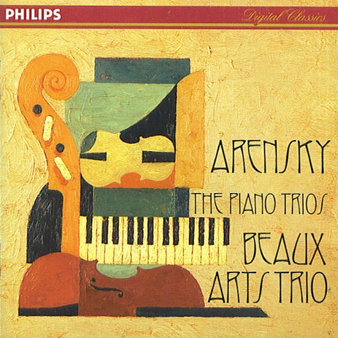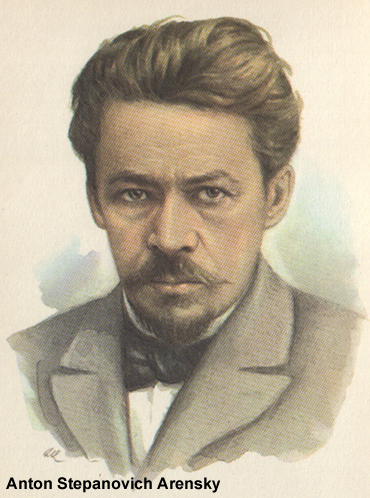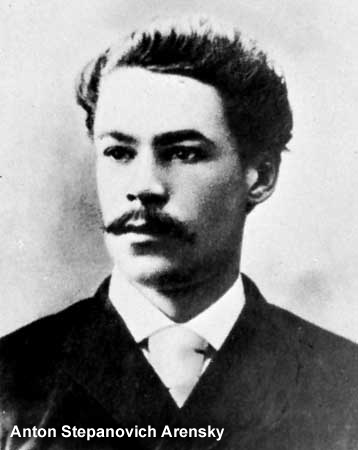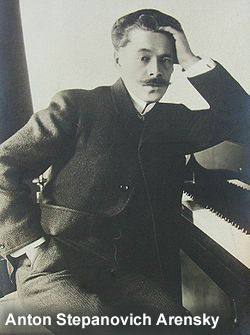 Anton Stepanovich Arensky (1861-1906)
Anton Stepanovich Arensky (1861-1906)
Piano Trio No. 1 in D Minor, Op. 32
Piano Trio No. 2 in F minor, Op. 73
Beaux Arts Trio
Recorded at Performing Arts Center, Purchase College, USA – June 1994 (Philips)
ONE-SENTENCE REVIEW:
Dude can write one hell of a gloomy melody – perfect for staring out an icy window at the frozen Moscow River on a miserable Sunday afternoon.
ORIGINAL LINER NOTES (by David Brown):
“In his youth Arensky did not escape some influence from me; later the influence came from Tchaikovsky. He will quickly be forgotten.” Thus Rimsky-Korsakov, not without a touch of pique, delivered his verdict upon his former pupil.
 Born in 1861, Arensky had become Rimsky’s composition student at the St. Petersburg Conservatory, but on graduating brilliantly with a gold medal in 1882, he had been appointed a professor at the Moscow Conservatory, where he was to teach both Rachmaninoff and Scriabin.
Born in 1861, Arensky had become Rimsky’s composition student at the St. Petersburg Conservatory, but on graduating brilliantly with a gold medal in 1882, he had been appointed a professor at the Moscow Conservatory, where he was to teach both Rachmaninoff and Scriabin.
Removal to Russia’s old capital brought Arensky into contact with Tchaikovsky, and the natural creative affinity between the two men fostered mutual friendship. Rimsky’s influence faded, and Tchaikovsky became not only the most potent single force within Arensky’s music but also his staunchest supporter.
After Tchaikovsky’s death Arensky composed his Second String Quartet as a memorial, producing in the string orchestra arrangement he later made of the quarter’s slow movement (Variations on a Theme of Tchaikovsky) one work that has remained firmly in the repertoire.
Nor has Arensky’s First Piano Trio suffered the fate Rimsky had so balefully predicted for his music generally. Composed in 1894, this too was a memorial work, this time for the cellist Karl Davidov, who had also been a kindly director of the St. Petersburg Conservatory during Arensky’s student years.
It is a splendidly accomplished piece – and also eclectic; sometimes, for instance, the first movement of Mendelssohn’s First Piano Trio, also in D minor, seems to lurk behind Arensky’s opening Allegro moderato. But where Mendelssohn was urgent, Arensky gives his first theme a gentle and very characteristically elegiac tone, and his inventiveness is powerful enough to ensure that what follows has clear individuality, even though it may lack the sheer personality of a Tchaikovsky – or Rimsky.
Arensky’s craftsmanship and clarity of thought are always impeccable, and this precision is even more evident in the scherzo. Not a note is wasted in this enchanting confection built largely from a little stuttering figure (which later nearly gives birth to a more extended melodic idea), flying scales, and sparkling piano figurations.
The centre betrays the trio’s most explicit debt to earlier music, but this powerful echo from the second movement of Saint-Saens’ Second Piano Concerto develops into a kind of lurching waltz very much Arensky’s own. There is careful revision of scoring when the scherzo returns, and a brief coda is added so that the movement may flicker into silence.
 The heart of this memorial trio is the slow movement.
The heart of this memorial trio is the slow movement.
Deeply elegiac it certainly is – but not funereal; it parades no formal grief, but rather seems to reflect on precious personal memories. With its tender central section, it is surely as affectionate a tribute as any many could wish for.
Nor does the final movement end with any tone of heavy lamentation. Nevertheless, the more lyrical tune that alternates with the forthright opening music harks back to the main theme of the Elegia, preparing us for the explicit recall of the gentle music from that movement’s centre.
There follows a recollection of the whole trio’s beautiful opening melody, its sadness enhanced by a delicately chromatic harmonization before a vigorous return to the finale’s opening material rounds off the whole work.
In 1895, a year after completing his First Trio, Arensky moved back to St. Petersburg to become director of the Imperial Chapel choir. He remained in the post six years, retiring in 1901 with a pension. He was not free to pursue very successfully his career as pianist and conductor, and to compose at will.
But his lifestyle had long been disorderly; drinking and an addition to gambling had undermined his health, and early in 1906 tuberculosis finally claimed him.
His Second Piano Trio of 1905 was therefore one of his last works. The work’s subsequent fate would seem to substantiate Rimsky’s prediction; in fact, its almost total disappearance from the repertoire has been very much our loss.
It would be facile to label this music autumnal, but thoughtful it certainly is. The clear sectionalism of the D minor Trio’s first movement here gives way to a more continuous, more spacious flow, and the opening five notes of the theme quietly enunciated by the piano become a pervasive presence (and also a motto motif that insinuates itself into the following three movements).
Other motifs are gathered along the way to contribute their part in generating an unobtrusively magisterial movement as fine as any from a Russian of Arensky’s generation.
 After such an impressive utterance, the main theme of the Romance might seem to promise something jejune, for all the telling harmonic detail in the accompaniment.
After such an impressive utterance, the main theme of the Romance might seem to promise something jejune, for all the telling harmonic detail in the accompaniment.
But the scale to which this theme grows confirms that Arensky’s greatest single asset was his melodic gift, and that gift is here confidently deployed to sustain the formidable span of an entire movement, braced the more firmly by the four haunting recurrences of the introductory four bars (the motto motif is heard just before the first theme returns for the last time).
The dazzling scherzo is as fleet and economical in texture as its counterpart in the First Trio, though its centre, with its disarmingly simple melodiousness, is more of a contrast (the motto motif quietly infiltrates this melodic flow at about midpoint).
After a truncated repetition of the scherzo, the finale’s quietly complex theme, with its contrapuntal opening and fastidious harmonic detail, might seem to be intractable material for variation treatment. But Arensky’s resourcefulness is equal to the challenge (especially in the weird valse of the third variation).
Several of the six variations seem deliberately to hard back to kinds of music heard in the preceding movements, and at the end of the grandiose final variation the motto motif builds a bridge to the coda, which returns to the reflective mood in which the movement had opened, drawing this sadly neglected work towards a muted but most satisfying resolution.
TRACK LISTING:
- 1-4: Piano Trio No. 1 in D Minor, Op. 32
- 5-14: Piano Trio No. 2 in F minor, Op. 73
FINAL THOUGHT:
Poor Arensky. So good but so flawed. Damn alcohol. Makes me so sad I need a really big drink (maybe at lunch!). But Anton Stepanovich did rate high enough to make it into the lyrics of a Kurt Weill and Ira Gershwin song (Tchaikovsky) and that’s good enough for me!
“There’s Malichevsky, Rubinstein, Arensky, and Tschaikovsky, Sapelnikoff, Dimitrieff, Tscherepnin, Kryjanowsky, Godowsky, Arteiboucheff, Moniuszko, Akimenko, Solovieff, Prokofieff, Tiomkin, Korestchenko…”
 Emily Sachs – President – Manka Music Group (A division of Manka Bros. Studios – The World’s Largest Media Company)
Emily Sachs – President – Manka Music Group (A division of Manka Bros. Studios – The World’s Largest Media Company)



We loved the composer so much we named our chamber orchestra after him!
http://www.theaco.co.uk/
Excellent!